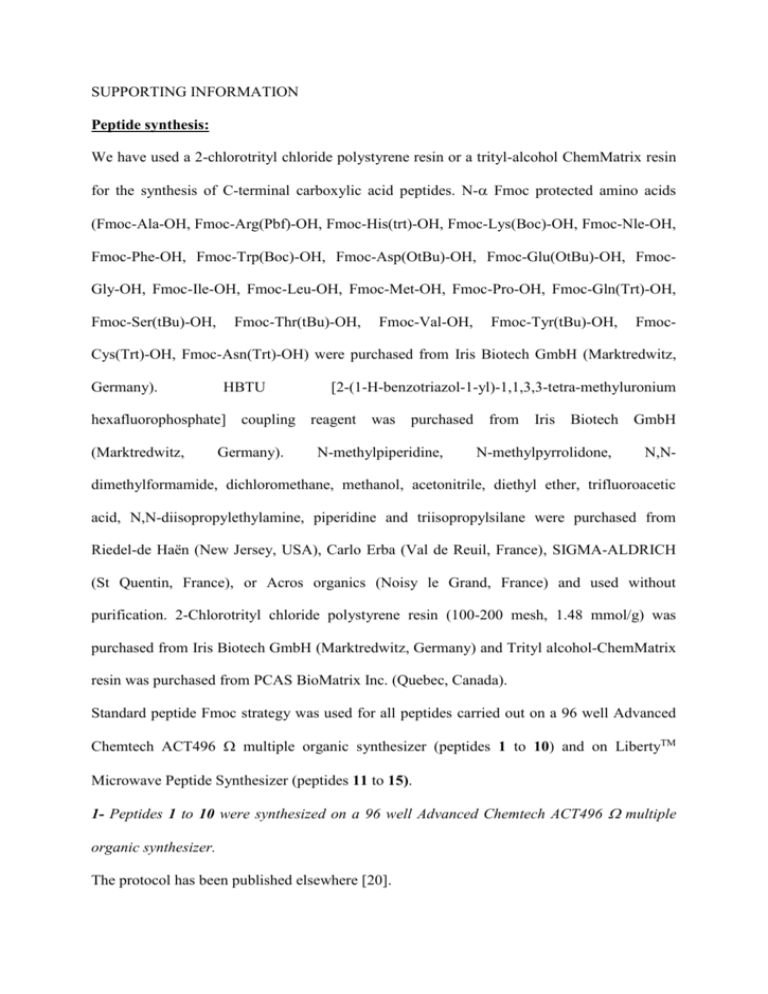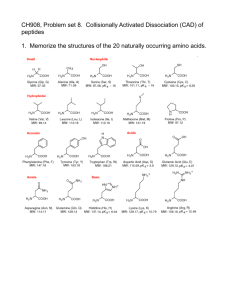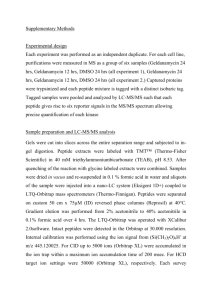SUPPORTING INFORMATION - Springer Static Content Server
advertisement

SUPPORTING INFORMATION Peptide synthesis: We have used a 2-chlorotrityl chloride polystyrene resin or a trityl-alcohol ChemMatrix resin for the synthesis of C-terminal carboxylic acid peptides. N- Fmoc protected amino acids (Fmoc-Ala-OH, Fmoc-Arg(Pbf)-OH, Fmoc-His(trt)-OH, Fmoc-Lys(Boc)-OH, Fmoc-Nle-OH, Fmoc-Phe-OH, Fmoc-Trp(Boc)-OH, Fmoc-Asp(OtBu)-OH, Fmoc-Glu(OtBu)-OH, FmocGly-OH, Fmoc-Ile-OH, Fmoc-Leu-OH, Fmoc-Met-OH, Fmoc-Pro-OH, Fmoc-Gln(Trt)-OH, Fmoc-Ser(tBu)-OH, Fmoc-Thr(tBu)-OH, Fmoc-Val-OH, Fmoc-Tyr(tBu)-OH, Fmoc- Cys(Trt)-OH, Fmoc-Asn(Trt)-OH) were purchased from Iris Biotech GmbH (Marktredwitz, Germany). HBTU [2-(1-H-benzotriazol-1-yl)-1,1,3,3-tetra-methyluronium hexafluorophosphate] coupling reagent was purchased from (Marktredwitz, Germany). N-methylpiperidine, Iris Biotech GmbH N-methylpyrrolidone, N,N- dimethylformamide, dichloromethane, methanol, acetonitrile, diethyl ether, trifluoroacetic acid, N,N-diisopropylethylamine, piperidine and triisopropylsilane were purchased from Riedel-de Haën (New Jersey, USA), Carlo Erba (Val de Reuil, France), SIGMA-ALDRICH (St Quentin, France), or Acros organics (Noisy le Grand, France) and used without purification. 2-Chlorotrityl chloride polystyrene resin (100-200 mesh, 1.48 mmol/g) was purchased from Iris Biotech GmbH (Marktredwitz, Germany) and Trityl alcohol-ChemMatrix resin was purchased from PCAS BioMatrix Inc. (Quebec, Canada). Standard peptide Fmoc strategy was used for all peptides carried out on a 96 well Advanced Chemtech ACT496 multiple organic synthesizer (peptides 1 to 10) and on LibertyTM Microwave Peptide Synthesizer (peptides 11 to 15). 1- Peptides 1 to 10 were synthesized on a 96 well Advanced Chemtech ACT496 multiple organic synthesizer. The protocol has been published elsewhere [20]. 2- The microwave synthesis of peptides 11 to 15 were performed by LibertyTM Microwave Peptide Synthesizer (CEM Corporation, Matthews, NC), an additional module of DiscoverTM (CEM Corporation, Matthews, NC) that combines microwave energy at 2450 MHz to SPPS following the fluorenylmethoxycarbonyl (Fmoc)/tert-butyl (tBu) strategy. Syntheses were conducted on a 0.1 mmol scale. Deprotections were performed with a 20% piperidine in DMF solution. All coupling reactions were performed with 5 equivalents of HBTU in DMF (0.5 M), 5 equivalents of amino acids in DMF (0.2 M) and 10 equivalents of DIPEA in NMP solution (2 M). Each deprotection and coupling reaction was performed with microwave energy and nitrogen bubbling. Microwave cycle was characterized by two deprotection steps; the first one was for 30 s, the second one for 180 s. All coupling reactions were for 300 s. After the assembly was complete, the peptide-resin was washed with CH2Cl2. Peptide cleavage from the resin and deprotection of the amino-acids side chains was performed with TFA/H2O/TIS solution (95:2.5:2.5 v/v/v). In all cases the cleavage was maintained for 3 h at room temperature. The resins were washed with TFA and the filtrates partially evaporated. The crude products were precipitated with diethyl ether, collected by centrifugation, dissolved in H2O/AcN and lyophilized. Peptide purification: Samples were dissolved in an acetonitrile/water (50/50 v/v) mixture, containing 0.1% TFA. The LC/MS autopurification system consisted of a binary pump Waters 2525, an injector/fraction collector Waters 2676, coupled to a Waters Micromass ZQ spectrometer (electrospray ionization mode, ESI+). All purifications were carried out using a X Bridge Prep C18 5 µM OBD 19x100 mm column. A flow rate of 20 mL/min and a gradient of 20–40% B over 5 min was used. Eluent A: water/0.1% TFA; eluent B: acetonitrile/0.1% TFA. Positive ion electrospray mass spectra were acquired at a solvent flow rate of 204 L/min. Nitrogen was used for both nebulizing and drying gas. The data were obtained in a scan mode ranging from 100 to 1000 m/z in 0.1 s intervals; 10 scans were summed up to get the final spectrum. Collection control trigger was set on single protonated and diprotonated ion with a MIT (minimum intensity threshold) of 7.105. Figure S1. Occurrence of amino acids in the prepared peptides Amino acids relative abundance (%) * Swiss-Prot 40 35 Natural peptides * Synthetic peptides 30 25 20 15 10 5 0 Aliphatic L, A, G, V, I Basic K, R, H Acid Not charged Aromatic E, D S, P, T, M, C, N, Q W, F, Y Amino acids Intens. [a.u.] Figure S2. MALDI MS/MS spectra of peptide 13 obtained upon a) LID/CID and b) LID conditions [M+H]+ 1544.74 S2a) peptide 13 (KWFGMLADQATYN) 2500 2000 1500 b b* N terminal Ion b° b-H2O a a* b-CO a° a-H2O y y* C terminal Ion y° y-H2O iX iX* Immonium Ion iX° Immonium Ion-H2O XX XX* Internal Ion XX° Internal Ion-H2O b-NH3 a-NH3 b8 949.33 y-NH3 Immonium Ion-NH3 Internal Ion-NH3 b6 763.29 b7 834.27 1000 b9 iK* GMLADQA 84.03 1077.36 b12 b10 1412.73 1148.42 b5 500 iK GML TY iW 159.05 WFG 1249.48 735.29 FGM FGML FGMLAD ADQ b3 FGMLA 315.07 b1 b11 a6 650.20 a7 520.14 687.20 449.12 806.32 a10 574.20 391.10 b13 a12 1384.65 1120.54 1478.33 265.07 iMiY 0 200 400 600 800 1000 1200 1400 Intens. [a.u.] m/z [M+H]+ 1544.755 S2b) peptide 13 (KWFGMLADQATYN) 3000 b8 949.229 2000 b7 b6 iK* 834.200 763.216 84.252 b9 GMLADQA b10 1077.314 b12 1148.337 b11 1412.616 1249.467 1000 GMLA FGM b1 ADQ 129.304 GM DQ 189.202 244.149 315.130 TY b5 ADQA FGMLAD 650.161 a6 WFG LADQ LADQA574.134 428.098 735.213 687.105 b13 a10 a7 806.261 1460.179 499.105 373.116 0 200 400 600 800 1000 1200 1400 m/z Intens. [a.u.] Figure S3. LID/CID MALDI MS/MS spectrum of arginine-containing peptide 10 S3. peptide 10 (KYIWLSRAV) 8000 6000 b b* N terminal Ion b° b-H2O a a* b-CO a° a-H2O y y* C terminal Ion y° y-H2O iX iX* Immonium Ion iX° Immonium Ion-H2O XX XX* Internal Ion XX° Internal Ion-H2O Scrambling* b-NH3 1036.643 a-NH3 y-NH3 Immonium Ion-NH3 Internal Ion-NH3 [M+H]+ 1135.658 iK* 84.066 4000 b7 947.551 iW iL 159.089 2000 b1 iK 129.101 IW/WL b2 300.189 y3 IW/WL-CO 272.184 197.161 iY LS a2 345.256 FGM b3 405.330 y4 y5 432.336 a3 377.312 b4 591.419 545.428 486.288 526.375 a4 -59 b5 704.483 a5 a8 y6 990.631 731.468 b6 676.518 463.302 y6* 518.425 y7 844.497 799.453 b7* 919.599 a7 1076.636 b8 b8* -44 -42 0 200 400 600 800 1000 m/z Intens. [a.u.] Figure S4. LID/CID MALDI MS/MS spectra of proline-containing peptides a) peptide 6 (KYPFEAL), b) peptide 9 (KEDFPQLMV). x104 S4a) peptide 6 (KYPFEAL) 2.0 1.5 b b* N terminal Ion b° b-H2O a a* b-CO a° a-H2O y y* C terminal Ion y° y-H2O iX iX* Immonium Ion iX° Immonium Ion-H2O XX XX* Internal Ion XX° Internal Ion-H2O 576.28 y5 b-NH3 a-NH3 y-NH3 Immonium Ion-NH3 Internal Ion-NH3 1.0 y6 739.33 PFE [M+H]+ 374.18 PFEA 867.39 445.21 b5 0.5 YP iK* iP 84.06 FE 245.12 iK b1 101.09 PF -CO iY y2 129.08 155.05 b2 217.11 203.08 b6 665.27 261.10 292.17 FEA y3 332.18 348.16 PFEAL b4 y4 a4 b3 468.50 389.22 YFP 536.28 YPFEA a5 637.29 508.26 558.28 -46 a6 708.33 608.25 754.34 b6* 821.42 0.0 100 200 300 400 500 600 700 800 Intens. [a.u.] m/z S4b) peptide 9 (KEDFPQLMV) y5 587.29 4000 3000 b7 858.37 b8 2000 989.43 [M+H]+ 1106.57 b4 PQL PQ 1000 b6 520.21 745.30 339.15 PQLM 226.07 DFPQL 470.21 iK* b3° a4 84.06 iP iK 101.07 b3 198.05 311.13 830.41 b5 492.21 y5* 373.15 iF 120.04 a6 y6 617.23 a6 392.09 964.26 0 200 400 600 800 1000 m/z Intens. [a.u.] Figure S5. MS/MS spectra of peptide 15 (KTRYNGMGEQWDPD) a) LID/CID in MALDITof/Tof, b) CID in ESI-QqTof from (M+H)+ precursor ion, c) CID in ESI-QqTof from (M+2H)2+ precursor ion. x104 S5a) peptide 15 (KTRYNGMGEQWDPD) 1.0 0.8 b b* N terminal Ion b° b-H2O a a* b-CO a° a-H2O y y* C terminal Ion y° y-H2O iX iX* Immonium Ion iX° Immonium Ion-H2O XX XX* Internal Ion XX° Internal Ion-H2O b12 1466.57 b-NH3 a-NH3 y-NH3 Immonium Ion-NH3 Internal Ion-NH3 0.6 [M+H]+ 1697.81 0.4 243.03 0.2 iR iK* 83.97 iY y2 iR b7 b3 203.07 136.00 386.10 QW 315.04 b4 566.21 a4 a5 635.19 1581.70 1037.37 1369.60 1654.70 1323.44 b5 1080.44 1165.59 0.0 200 400 600 800 1000 1200 1400 1600 m/z S5b) peptide 15 (KTRYNGMGEQWDPD) b12 b3 GE b9 b1 a9 iK iR a11 y2 b3* iW a5 b5 YGN QWD a4 b12* b9* [M+H]+ S5c) peptide 15 (KTRYNGMGEQWDPD) y2 b122+ b12 QWDP b102+° b102+* QWD b102+ b112+ QW/ -CO b5 CEQ b3 b92+ b4 y3 iK iW y2* TRYNGMGEQWD [M+2H]2+ b122+° b122+* RYNGMGEQWD b9 [-NH3] 2+ b10 b7 b8 b9* y10 a10 a11 b11 b12° b12* y13 Intens. [a.u.] Figure S6. MS/MS spectra of peptide 7 (KMVNLHIQ) a) LID/CID in MALDI-Tof/Tof, b) CID in ESI-QqTof from (M+H)+ precursor ion, c) CID in ESI-QqTof from (M+2H) 2+ precursor ion. b6/y6 S6a) peptide 7 (KMVNLHI) 6000 4000 723.36 b7 b b* N terminal Ion b° b-H2O a a* b-CO a° a-H2O y y* C terminal Ion y° y-H2O iX iX* Immonium Ion iX° Immonium Ion-H2O XX XX* Internal Ion XX° Internal Ion-H2O 836.44 b-NH3 a-NH3 y-NH3 Immonium Ion-NH3 y3 Internal Ion-NH3 397.23 [M+H]+ 982.54 2000 a6 b5 695.38 586.32 a7 y5 LH/HI iH iK*110.07 84.07 b1 LHI MVN 365.20 LH/HI-CO 223.14 129.08 y2/b2 y7 a5 510.29 251.13 525.27 b4 808.47 624.33 y4 558.34 854.43 MVNLH b4* MVNLHI 456.25 345.16 436.25 0 100 200 300 400 500 600 700 800 900 1000 m/z LH / HI S6b) peptide 7 (KMVNLHIQ) y3 b6 -CO NLH a6 iH VNLHI VNLH y2/b2 NLHI MVN b1 y1 b7 a7 b5* b5 b4* y4 iK* b4 [M+H]+ a6* a5 a7* VNL VN b6* MVNLH y5 b7* -NH3 S6c) peptide 7 (KMVNLHIQ) b1 [M+2H]2+ iK* y1 b62+ y2/b2 iK iH y3 a62+ LH/HI iL MVN iM MV-CO -CO NLH a62+* a3 VNR b72+ VNLH [-NH ]2+ 3 -CO VNLH y72+ MVNL y4 VNLHI MVNLH b5 y5 y6/b6 Figure S7. LID/CID MALDI MS/MS spectra of lysine-containing peptides inside the sequence a) peptide FVAEKFA and b) peptide AFAMVGKLAE, and c) at the C-terminal position, peptide WGVYAPLFDK. S7a) peptide FVAEKFA b6 y3 b5 b4 b1 b b* N terminal Ion b° b-H2O a a* b-CO a° a-H2O y y* C terminal Ion y° y-H2O iX iX* Immonium Ion iX° Immonium Ion-H2O XX XX* Internal Ion XX° Internal Ion-H2O b-NH3 a-NH3 y-NH3 Immonium Ion-NH3 Internal Ion-NH3 y5 y4 AEK b2 EK b3 b2° b6° y4° iK* iF iE a6 a4 AE a2 [M+H]+ y6 VAE a5 S7b) peptide AFAMVGKLAE b8/y8 y5 b9 b4 b3 y6 y4 b7 y7 VGK a8° GK b1 VGKL b2/y2 iK* a4 a5 b6 AMVG KLAL a8* y9 a9 [M+H]+ S7c) peptide WGVYAPLFDK y5 y6 y7 y3 PL iW iP b2 y2 PLFD PLFGK b3 b3 b5 a3 YAPL y8 b7 a5 PLF a6 b6 a7 b8 a8 y9 [M+H]+






